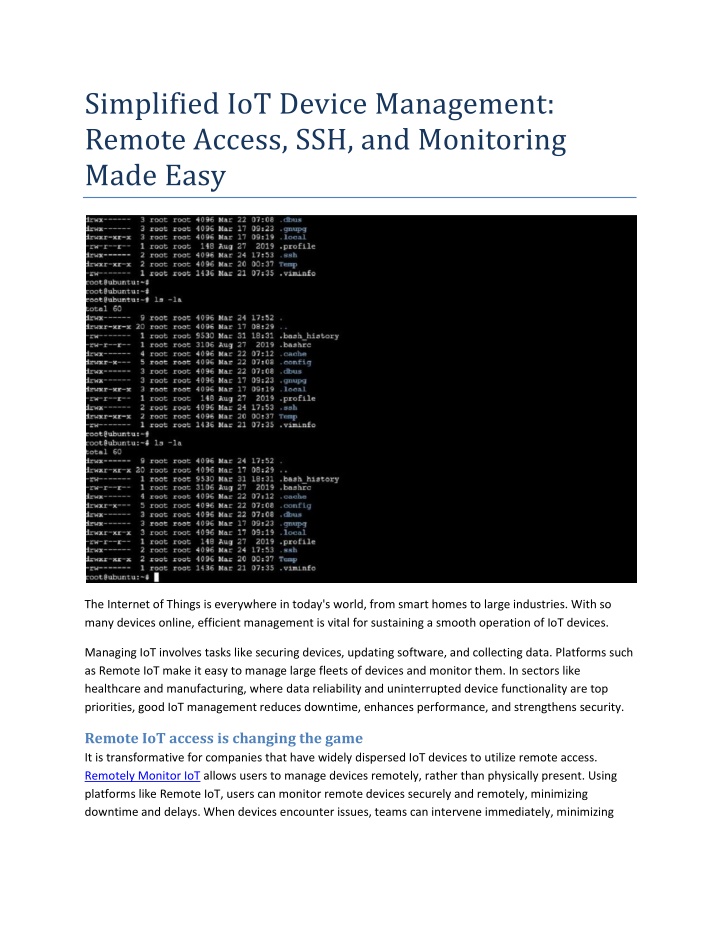Best SSH Remote IoT Device Solutions: Secure Access Guide
In an age where everyday objects are increasingly interconnected, securing these devices from unauthorized access is not just an option, it's a necessity. The best SSH remote IoT device solutions are the bedrock upon which a secure, accessible, and manageable Internet of Things infrastructure is built.
This article delves into the realm of secure remote access for IoT devices, leveraging the power of SSH (Secure Shell). The exponential growth of the Internet of Things (IoT) has brought with it a parallel increase in the urgency to safeguard these connected devices. From smart home appliances to industrial sensors, the potential attack surface has expanded dramatically, making the need for robust security measures, particularly for remote access, more critical than ever. The solutions discussed here aim to provide actionable insights and practical solutions for optimizing your IoT management strategies, ultimately making your devices more secure and your life easier.
Choosing the right SSH tool can significantly impact your remote access experience. The selection process demands careful consideration of factors like performance, security, and compatibility. This guide is designed to empower you to make informed decisions that align with your specific needs.
- Jameliz Video The Ultimate Guide To Exploring Viral Content And Beyond
- Leaked Mss The Untold Story You Need To Know About
One of the most reliable methods to secure IoT devices is by utilizing SSH. This technology provides a secure, encrypted channel for remote access, ensuring that data transmitted and received remains protected from eavesdropping and tampering. By exploring the best SSH solutions specifically tailored for IoT environments, you can ensure that your devices remain protected while maintaining seamless connectivity.
| Feature | Details |
|---|---|
| Definition | The technology, typically used for secure remote access to IoT devices, providing a protected, encrypted channel for data transfer and device management. |
| Purpose | To enable secure remote access and management of IoT devices while protecting them from unauthorized access and data breaches. |
| Key Components | SSH server installation, key generation and management, and firewall configuration to control access. |
| Importance | Plays a crucial role in safeguarding connections, preserving data privacy, and streamlining device management. |
| Common Implementations | Utilized with devices running lightweight operating systems like Linux. |
| Security Enhancements | Password authentication, key-based authentication, and regular security audits are critical. |
| Benefits | Ensure the IoT infrastructure is both accessible and secure, protecting sensitive data and enabling seamless operations. |
| Considerations | Performance, security, and compatibility are important factors when choosing an SSH solution for IoT devices. |
| References | Example.com - SSH and IoT Security |
The setup process for SSH on IoT devices often involves several key steps. Initially, you need to install an SSH server on the target device. This process may vary depending on the specific operating system your IoT device is running, but generally involves using a package manager to install an SSH daemon such as OpenSSH. Following the installation, you will typically generate a set of cryptographic keys a public key and a private key to establish secure authentication. The public key is placed on the IoT device, while the private key remains securely stored on your access device. Finally, you'll need to configure firewall rules to allow SSH traffic to pass through, typically on port 22, while also potentially limiting access based on IP address or other security criteria. Most IoT devices often rely on lightweight operating systems like Linux, which provides a solid foundation for this process.
Setting up SSH for your IoT devices involves several steps. After installing an SSH server, you then configure it, often by editing the sshd_config file. This configuration process allows you to customize settings such as authentication methods, port numbers, and security protocols. Securing the connection involves several critical steps, including using strong passwords or, ideally, key-based authentication to protect against brute-force attacks. Testing the setup ensures that you can successfully connect to the IoT device remotely and that the connection is secure. Many IoT devices run on lightweight operating systems like Linux, making them suitable for these configurations.
- Wasmo Telegram Link 2022 Your Ultimate Guide To Joining The Trend
- Gore Videos Website The Dark Side Of The Internet Explored
As SSH is a critical component in securing remote access to IoT devices, additional steps are vital for enhancing the security of your SSH connections. One important practice is disabling password-based authentication and enforcing key-based authentication, which involves using cryptographic keys instead of passwords, significantly reducing the risk of unauthorized access. Regular security audits and monitoring are essential, including reviewing SSH logs for suspicious activities, such as failed login attempts or unusual connection patterns. Keeping the SSH server software up to date with the latest security patches is crucial to address any potential vulnerabilities that could be exploited. Another critical aspect is limiting access by implementing firewall rules that only permit SSH traffic from trusted IP addresses or networks. These measures collectively harden your SSH infrastructure, enhancing the overall security of your IoT deployments.
To illustrate this practically, consider a scenario where a smart home system utilizes SSH. Imagine the homeowners want to remotely monitor and manage their smart thermostat, security cameras, and lighting system. They would begin by installing an SSH server on their Raspberry Pi or other central control unit. Next, they would generate an SSH key pair and copy the public key to the IoT devices, such as the thermostat and cameras, establishing secure authentication. They would also configure their router's firewall to only allow SSH connections from a trusted IP address range. By implementing these practices, they can securely access and control their smart home from anywhere in the world, protecting their sensitive data and ensuring the smooth operation of their devices.
A virtual private network (VPN) can be a secure way to remotely connect to IoT devices, especially when these devices are behind a firewall or a private network. By establishing a VPN tunnel, you encrypt all data transmitted between your device and the IoT devices, protecting it from eavesdropping. In more professional or industrial settings where IoT devices may be handling sensitive data or where direct remote access to devices is required, the use of VPNs is even more crucial. This adds an extra layer of security to your IoT infrastructure.
The best SSH remote IoT device free solutions offer a secure and reliable way to manage and monitor your devices from anywhere. Whether you're a hobbyist, developer, or professional, understanding these tools is essential for optimizing your IoT setup. The selection process is not just about specifications; finding the right fit is paramount to meeting your unique requirements.
The importance of choosing the right SSH solution cannot be overstated. The criteria to consider are performance, security, and compatibility. Performance relates to how efficiently the SSH server handles connections, transfers data, and responds to commands. Security must be the highest priority; assess how well the SSH solution protects against unauthorized access, data breaches, and other security threats. Compatibility ensures that the chosen solution functions smoothly with your specific IoT devices, operating systems, and network infrastructure.
In today's interconnected world, the Internet of Things (IoT) is rapidly expanding, connecting billions of devices to the internet. These devices are constantly generating and exchanging data, making secure remote access solutions more critical than ever. By carefully selecting the right SSH remote IoT device solution, you can protect your devices, data, and operations from threats.
Setting up SSH on your IoT device is a straightforward process. Start by installing an SSH server on your device, and then configure the SSH server by editing the sshd_config file to suit your needs. Following these steps ensures that your IoT devices are both accessible and secure, protecting sensitive data and enabling seamless operations. The goal is to create a secure and manageable IoT infrastructure.
- Unveiling The Best Gore Website A Deep Dive Into The Dark Corners Of The Internet
- Ellaalexandraxo The Rising Star Whorsquos Lighting Up The Internet

Best Remote IoT Device SSH A Comprehensive Guide For Secure Connections

PPT Simplified IoT Device Management Remote Access, SSH, and

How To Securely Connect Remote IoT Devices Using P2P SSH On Ubuntu